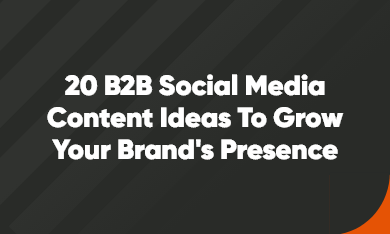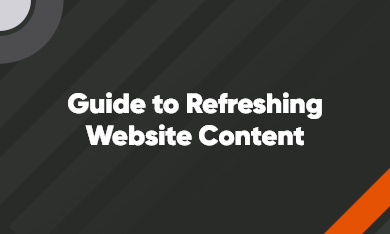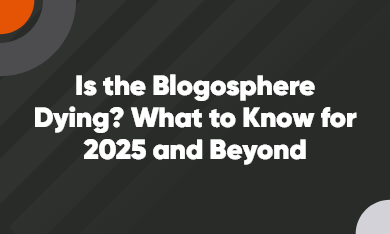
Is Gated Content Still a Smart Marketing Play in 2025?
Once upon a time (like, 10 years ago), marketers threw PDFs behind forms on an everyday basis. Whitepapers, eBooks, industry reports—gated content was undeniably the move, as businesses teased their deepest, most valuable insights to capture lead data and start working the funnel.
But here we are in 2025, and things have changed. A lot.
Consumers are savvier. Privacy regulations are tighter. And people are just sick of trading their email for a glorified blog post in disguise. So the big question is: Does gated content still have a place in your content marketing playbook? Or is it time to let that gate swing wide open?
Let’s take a look.
First… What is gated content?
For the uninitiated, gated content refers to any type of content that lives behind a form—usually requiring users to enter things like their name, email, company, and title just to access it.
Things like:
- eBooks
- Whitepapers
- Case studies
- Webinars
- Research reports
- Templates or tools
The idea is simple: you offer something valuable, they give you their info. Lead captured. Job well done, right?
Well… maybe.
The Golden Era: Why gated content worked (and sometimes still does)
Let’s be fair—gated content used to crush it.
During the heyday of inbound marketing, offering a downloadable guide on “10 Ways to Save on Cloud Storage Costs” could net you hundreds of leads. It felt like magic. Sales teams rejoiced. Marketing dashboards lit up.
And for B2B companies, especially those with long sales cycles, it was a no-brainer. You needed a way to identify, nurture, and eventually convert site visitors into buyers. Gated content fit the bill.
Many B2B marketers are still able to use gated content effectively in some form, so it’s not to say that it’s entirely dead. It’s just not quite the golden goose it used to be anymore.
What changed? (Spoiler: everything)
Here are some of the top reasons gated content is under fire in 2025:
1. User expectations have shifted
People don’t want to “request access” to your PDF manifesto anymore. They want instant answers and gratification, and they want them now. Gating content slows down that process.
The dramatic rise of platforms like TikTok, Reddit, and YouTube Shorts in recent years has changed how users engage with information, making pretty much everything much more scrollable, digestible, and most importantly—free.
2. Privacy regulations are tighter
GDPR. CCPA. CPRA. Whatever acronym is coming next. Data privacy regulations have made form-gated content more complex. You can’t just throw up a form and start blasting emails anymore (not legally, at least). Users are also increasingly wary of handing over their personal info, throwing another wrench in the once seamless gated content experience.
3. Fake leads, fake emails, real problems
Any marketer today will tell you that they are more or less drowning in junk leads on an hourly basis. People have become increasingly shameless in their efforts to get past your form without committing to a real relationship. So while you might generate 1,000 “leads” from that new guide you dropped… how many of them are actually valuable?
So… Should you just ungate everything?
Not necessarily.
There’s a growing movement in the marketing world advocating for ungated or “free to access” premium content—and for good reason.
Benefits of ungating content:
- Better SEO: Google can’t crawl content behind a form. Removing the gate = more indexable content = more organic traffic.
- Brand trust: You look more generous, helpful, and confident when you ungate your content. Like you don’t need to hoard your knowledge.
- Wider reach: Shared content spreads faster when it’s not behind a form. More eyeballs, more impact.
But what about generative search?
With tools like Google’s AI Overviews and other generative search features rolling out, the content that shows up in AI-driven summaries is pulled from accessible, crawlable sources. That means if your best stuff is hidden behind a gate, it’s not going to be included in AI snapshots—period.
Translation? You could be losing major real estate in the new search landscape just because your content is invisible to crawlers.
So while gating might help you collect leads, ungating helps you get found. In 2025, that visibility in generative search engines can be just as valuable—if not more. Just make sure you're measuring the impact of your generative engine optimization efforts.
But before you rip the gates off every asset you’ve got, it’s important to ask…
What’s the goal of the content?
Not all content serves the same purpose. Here’s a helpful way to think about it:
|
Content Purpose |
Gate It? |
|
Increase brand awareness |
No, ungate it |
|
Improve SEO rankings/GEO visibility |
No, ungate it |
|
Establish thought leadership |
No, ungate it |
|
Generate qualified leads |
Maybe, if valuable |
|
Support ABM campaigns |
Yes, selectively |
|
Offer tools/templates |
Yes, if high value |
Put simply: don’t gate crap. Only gate content that’s genuinely useful and worth the trade.
A look at hybrid models
Some of the savviest marketers in 2025 are getting creative. Here are a few smart ways to “gate” content without ruffling your audience’s collective feathers:
1. Tease, then gate
Show a preview—maybe the intro and first section of your eBook—then invite users to download the rest. That way, they can have a better idea of what they’re getting in exchange for their info.
2. Progressive gating
If someone’s already downloaded one resource from you, don’t go asking for their info all over again the next time. Cut down on the form fields and only ask for the information you need. Try using cookies, CRM integrations, or platforms like HubSpot to progressively profile users throughout the funnel, gathering information over time rather than all at once.
3. Gated with a value exchange
Tell users exactly what they’ll get, and why it matters ahead of time. Be specific. Think “Download our 2025 SaaS Pricing Trends Report (based on 1,000+ companies)” vs. “Download our whitepaper.”
Real-world example: The gated/free combo
Let’s say your agency builds a comprehensive guide called:
“The 2025 B2B Marketing Playbook: 42 Pages of Strategy, Tools, and Tactics”
Here’s how you could structure it:
- Post a 1,200-word blog summarizing the core takeaways (SEO win).
- Include a preview carousel of the first few pages (trust win).
- Gate the full downloadable version (lead win).
- Use the download as a signal for your sales team to start a conversation (pipeline win).
Now you’ve got one simple asset doing four jobs at once, which is typically the kind of ROI marketers and business owners dream about.
So, is gated content still smart in 2025?
Yes—if you use it sparingly, strategically, and with respect for your audience.
Gated content isn’t dead, but it has transformed significantly from the lazier lead magnet it used to be. If you’re still tossing a PDF behind a form and calling it a day, you’re simply not playing to win.
The new game in 2025 is about building trust, earning attention, and offering real value—not just collecting email addresses for sport.
TL;DR
- Gated content still works—but only when it’s actually worth gating.
- Audiences are smarter, privacy laws are stricter, and SEO matters more than ever.
- Ungated content boosts reach, trust, and discoverability.
- Use hybrid models: tease, preview, personalize, and only gate when the value is undeniable.
Ready to create content that converts?
Whether you’re looking to bolster leads, build an SEO powerhouse, or launch a paid media campaign that demolishes the competition—Perrill is ready to help.
We’re a full-service digital agency that knows how to blend strategy, creativity, and performance across every channel. From content marketing and SEO to paid media, social, and web, we don’t just talk about results. We deliver them.

Dan Cole
Author
Dan Cole
Categories
Date
Explore with AI
Join Our Newsletter


Guide to Refreshing Website Content


Is the Blogosphere Dying? Here’s What You Need to Know for 2025 and Beyond.


